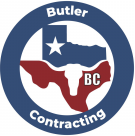While concrete is still often used to sink wood posts, it’s not always the best option long term as the concrete tends to lock moisture into the wood which contributes to rotting. There are several other methods of sinking a post, such as gravel, crushed rock, compacted dirt and fence post anchors that allow setting a post without sinking it into the soil. Our preference at Butler Contracting is to simply drive the post deep into the ground when the terrain allows for it.
If you would like to explore the options available when sinking in posts, the following information should help you identify what method is going to work best for you according to the climate you live in the ground type your building on.
Setting Fences in Concrete
One of the most popular ways to sink a post is with concrete. It provides a reliable stability in most cases to hold up your fence and keep it sturdy for a long time. Where concrete becomes a problem sometimes, is with wood fence posts. Wood has a tendency to rot over time under certain conditions and when a post rots, you can simply replace it with a fresh post. But when the base of that post is encompassed with concrete, you’ll have to dig a sizable hole to get it out – it’s certainly not an ideal situation. There are precautions that can be taken to help prevent wood rot, like fence post collars. These collars keep the microbes in the soil from making contact with the wood, thus preventing the fungus that causes the rot to grow and eat away at the post. It’s an extra expense, but it can serve to prolong the life of the post and keep your replacement costs to a minimum.
When to Use Gravel
If you are building on harder clay-like soil, gravel can be a good option, but if you’re on soft or sandy dirt, the posts will probably come loose. The benefit of using gravel as opposed to concrete is that gravel allows for proper drainage at the base of the post whereas concrete can lock in water and moisture leading to rot. Gravel is also a good option for climates that freeze over often as it handles the expansion and contraction that the cold causes in the ground better than concrete.
Crushed Rock
Crushed stone, also known as angular rock, is similar to gravel, but it comes in larger chunks. It has the same benefit of providing drainage while acting as a stable base for the post. Sometimes a combination of crushed rock and concrete is used. A base layer of crushed rock can provide drainage at the base while the concrete stabilizes the post closer to the surface.
Compacted Dirt and Driving Posts
There’s nothing wrong with keeping it simple, and at Butler Contracting we like doing simple better. In order to have the best success when using dirt, the size of the hole needs to be as close in diameter as possible as the post going into it. The best way to achieve this is to simply drive the post into the ground, which is our preference should the ground conditions allow for it. Driving the post into the ground allows for less soil displacement sinking the post down into the natural clay layer allowing for a much stronger stable fence.
Post Anchors
Fence post anchors come in various designs, but the basic concept is a metal steak with a pointed end that has some sort of bur-like mechanism that grips the earth after the steak end is driven into the ground. The other end of the anchor has a bracket that the post easily slides into and is secured with screws. The post doesn’t actually go into the ground which helps prevent rot while the anchor holds the post securely in place.
Contact Butler Contracting, Today!
We’ve been building fences for many years in the Bastrop County area and can help you determine which type of fence material and post sinking method is going to work best for your needs. Try out our Fence Estimator Tool to get the process started!



